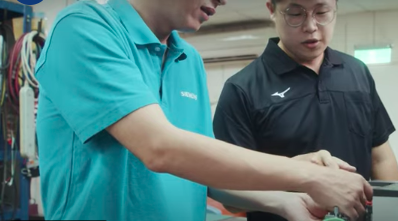
From material selection to process optimization, Xinda helps you enhance the durability and quality of your spring products.
Spring Material and Temperature Recommendations: Xinda Helps You Choose the Right Materials and Optimize Production
Extend Spring Life and Enhance Production Efficiency
In the manufacturing process, springs are indispensable components. The performance and lifespan of springs directly affect product quality and user experience. Therefore, choosing the right spring material and application temperature is crucial.
However, many spring manufacturers encounter various issues when selecting spring materials and application temperatures, such as spring breakage, decreased elasticity, and reduced lifespan. As a professional spring machine manufacturer, Xinda not only provides high-quality equipment but also strives to help customers solve real production problems.
Here are some common spring material and temperature issues and their solutions:
Issue 1: SUS304 Spring Stiffness Changes at -20°C
SUS304 is a stainless steel material known for its excellent corrosion resistance and low-temperature properties. At -20°C, the elastic modulus of SUS304 springs increases by about 1%, and the spring constant slightly improves. However, the actual difference may vary depending on the shape.
Recommendations:
• Consider performance changes in low-temperature environments when designing SUS304 springs.
• Leave some margin in design if high stiffness is required.
Issue 2: Low-Temperature Annealing Temperature for SUS304-WPB Wire
Low-temperature annealing is a heat treatment process used to remove residual stress and improve the mechanical properties of the material. For SUS304-WPB wire, it is recommended to anneal at 400°C.
Recommendations:
• 400°C is the low-temperature annealing temperature for SUS304-WPB wire, suitable for all wire diameters.
• Low-temperature annealing can enhance the spring's anti-sag and fatigue performance.
Issue 3: Typical Working Temperature Range for Helical Springs
The upper working temperature limit for stainless steel SUS304 helical springs is about 250°C, and the lower limit is about -150°C. However, the upper and lower stress limits should be set low during use.
Recommendations:
• Avoid using springs in extreme temperatures.
• Consider the operating temperature range when designing springs.
Issue 4: Effects of Black Oxide Process on SUS304 Springs
The black oxide process can remove residual stress in SUS304 springs, enhancing their anti-sag and fatigue performance. Additionally, this process can improve the surface hardness and wear resistance of the springs.
Recommendations:
• For SUS304 springs used in harsh environments, consider black oxide treatment.
• The black oxide process can extend the spring's lifespan.
Issue 5: Durability Comparison Between SWP-A and SUS304-WPB
Under the same load conditions, SWP-A has higher tensile strength than SUS304-WPB, making it more durable.
Recommendations:
• If high durability is required, choose SWP-A material.
• Note that SWP-A is typically more expensive than SUS304-WPB.
Issue 6: Increasing Reaction Force Without Changing Wire Diameter or Shape
To increase the reaction force without changing the wire diameter or shape, use materials with a higher Young's modulus, such as music wire or oil-tempered wire.
Recommendations:
• Using materials with a higher Young's modulus can increase the spring's reaction force.
• Non-corrosion-resistant materials like music wire may need rust prevention treatment.
Issue 7: Initial Tension Changes in Extension Helical Springs
Initial tension in extension helical springs is affected by temperature and load. At room temperature, the initial tension almost does not decrease. However, at high temperatures, the initial tension decreases as the temperature rises. Also, if stored under load, the initial tension will drop in the early stages.
Recommendations:
• Avoid storing extension helical springs in high temperatures or under load.
• Choose springs with higher initial tension for high-temperature or load applications.
Issue 8: Comparison Between SUS301 and SUS304
SUS301 and SUS304 are common stainless steel materials for springs. SUS301 has higher work hardening and strength, while SUS304 offers better stability.
Recommendations:
• Choose SUS301 if higher strength is required.
• Choose SUS304 for better stability.
With its professional technology and extensive experience, Xinda is committed to providing the most suitable spring machine equipment for customers. We understand the various challenges in spring production and can offer optimal solutions for different needs. Using our equipment can significantly enhance production efficiency and product quality, reducing issues in the manufacturing process.
We understand the impact of choosing the right spring material and application temperature on spring life and performance. Therefore, we provide comprehensive technical support and professional advice to help you make the right decisions during production. Whether it's selecting materials for low-temperature environments or addressing technical issues to improve spring durability, we can provide expert answers and practical recommendations.
Don't let various spring production problems bother you anymore. Choose Xinda and let us be your best partner. Contact us now to learn more about our spring machines and let us help you solve your production issues.
